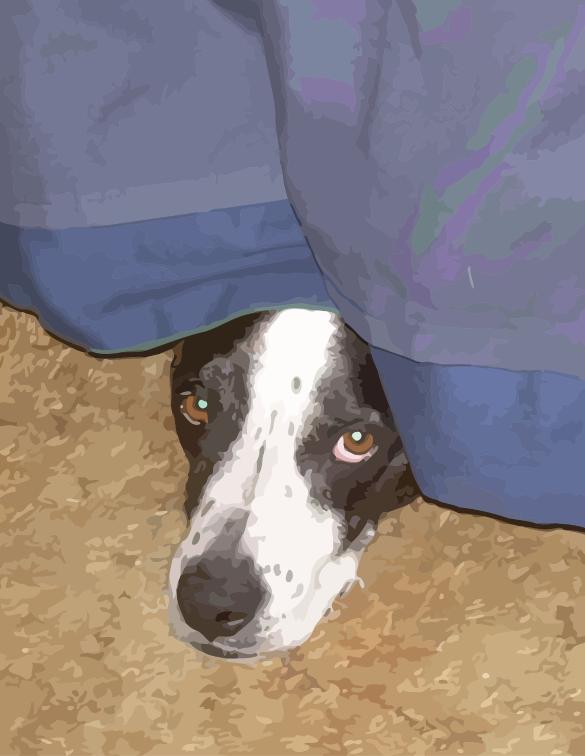Fears and Phobias: Dog's Have Them Too!
Table of Contents

Fear is part of a dog's survival strategy when threatened. When facing an object it does not recognize or one that behaves inexplicably, its natural reaction is to back away or—if it cannot escape—growl, bark, or snap in a show of defensive aggression. Dogs have sensitive hearing and are startled by loud, sudden noises, yet we expect them to share our lack of concern for the washing machines, vacuum cleaners, doorbells, telephones, and other background noises that fill our lives. Early education is essential to prevent a dog reacting fearfully to such stimuli.
Excessive fearfulness in a dog often results from a combination of genetic and environmental factors. Fearful parents are likely to pass on the trait to their offspring, which is why it is so important to breed only from animals of equable temperament. A puppy will imitate and learn timidity from its mother or any other adult dog that belongs to the household. Obviously, bad handling and cruelty will instill fear into any animal and reinforce a tendency to timidity in one that is already fearful by nature. Nervous owners can contrive to make their dogs nervous—by communicating feelings of fear during a thunderstorm, for instance.
Extreme Fearfulness
A fearful dog is not a happy dog. Its lack of confidence will inhibit learning, make training difficult, and may lead to aggression. Fear can also induce phobias—an extreme reaction to particularly intense stimuli such as firecrackers, emergency alarms, or electrical storms. Phobias can be extremely debilitating. The dog may shake uncontrollably, salivate, whine, urinate, crawl under the bed, or try to to dig a hole in which to hide. It is natural for a concerned owner to want to pet and fuss over the dog, but this will only increase its anxiety. Use a firm, confident tone of voice instead to show that you are fully in control of events. Reward the dog with praise or a tidbit if it begins to calm down (avoid physical contact as you may inadvertently pass your own anxiety on to the animal). If the stimulus comes from outside, close all windows and doors, play music, or turn on the TV to mask the sounds. Encourage the dog to stay in a secure place, such as a favorite chair or its own bed.
Associated Phobias
Sometimes it is the association of one stimulus with another that initiates a phobic reaction. For example, a dog may cower at the sound of rain as it hits the window because it associates the noise with thunder, even though the rain is gentle and there isn't a storm raging. A fear of loud bangs may extend itself to fear of any door or window being closed or a chair being pushed back from the table. If the source of the fear is linked to a particular place such as the backyard or car, the dog may become unwilling to go there. Agoraphobia can develop: the dog has to be dragged out for walks and runs home in blind panic if it is allowed off the leash. You should consult your veterinarian who may prescribe anxiety-reducing medication and refer you to a behavior counselor. Problems like this normally have complex origins. Professional help is needed to unravel the causes and formulate a suitable program of treatment.
Q&A
My dog, Biggies, has an extreme fear of loud noises such as firecrackers. My vet thinks that medication might help him. Will he get hooked on the drugs?
The common anti-anxiety drugs given to animals do not cause dependency, but the use of all drugs should be carefully monitored for side effects. Your vet will certainly do this, and will not prescribe them unless Biggies is 1 00 percent healthy—a blood test can check this. The drugs alone do not effect a cure, just help the behavior modification to work.
Liesl, my Weimaraner, was riding in the back of my car when someone broadsided us. Two months later Liesl is still terrified of going in the car. What should I do?
Dispel Liesl's fears of the car by feeding her outside, choosing a spot from where she can see the car but is not too close to it. Tell her to sit and then place the bowl in front of her. Add a tasty morsel, such as a piece of chicken, to increase her enthusiasm and try to feed her small amounts several times a day. Let her eat only if she is calm. Gradually work your way closer to the car until she will feed beside or in it. When she's used to that, feed her with the engine running (reduce the amount of food you give her at this stage). Take Liesl on short journeys and give her a walk or game at the end to reinforce the association of the car with pleasant things. It will take time and constant repetition at every stage, but Liesl should slowly lose her fear.



Leave a Reply